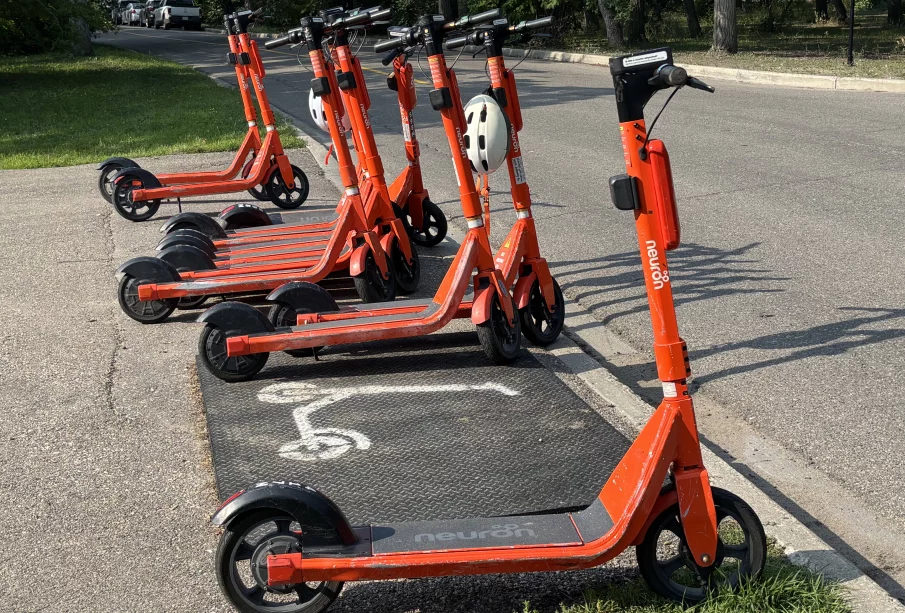Rentable e-scooters are readily available, but there are limitations
Electric kick scooters, or e-scooters, are all the rage these days. Some people are choosing to use e-scooters as their primary means of transportation during the warmer months. For many others, it’s just for fun.
If you’ve got a phone and a credit card, there are numerous spots where you can grab one and start riding – including close to the university.
At the Carillon, we were wondering: wouldn’t it be handy to grab a scooter if you were on the wrong side of campus and late for class?
Alas, the reality doesn’t quite match the dream.
Pretty easy to rent an e-scooter
The orange electric scooters you might’ve seen around Regina are from a company called Neuron.
After downloading the Neuron app, riders must scan the e-scooter to unlock it. The rental is $1.15 to unlock plus 39 cents per minute, with sales tax added on top of that.
Of course, there are restrictions that limit where you can and can’t ride the scooters. This is known as “geofencing.”
Neuron’s three types of geofences are “low speed zones,” “no riding zones,” and “no parking zones.” These zones can be seen on maps displayed on the Neuron app.
The low speed zones limit the e-scooter speed to the speed limit in that area.
The no riding zones have a boundary surrounding the service area. If you leave your scooter outside of the service area, you might get a penalty charge. If you enter a no riding zone, your scooter will be disabled and you won’t be able to “end your trip” through the Neuron app.
Lastly, no parking zones won’t allow you to end your trip and park your e-scooter.
It would’ve been great if I had known this basic information ahead of time before riding an e-scooter… but I didn’t, and ended up going into it blindly.
E-scooter rookie tries it out
My experience riding an e-scooter for the first time was definitely interesting, to say the least.
I was hoping to locate a rentable e-scooter close to campus, south of University Drive North and the Archer Library, but on that particular day, there weren’t any fully-charged ones available.
I headed over to the second-closest place to try an e-scooter, on Kramer Boulevard by the McDonald’s, and found one to ride.
I scanned my scooter and walked it over to a bike path near campus where I could start riding.
I was a bit surprised by how quickly the e-scooter started going when I began accelerating – and that’s probably why you’re required to wear a helmet. Riding these things can be dangerous if you’re not careful.
I found riding the e-scooter kind of fun … but it didn’t last for long. All of a sudden, the scooter started slowing down even though I wasn’t braking. It wouldn’t let me accelerate anymore.
Then, the scooter started speaking, saying that I was “leaving the service area.”
I realized that the service area was probably where I had gotten the e-scooter from, back on Kramer Boulevard.
This was disappointing because I wanted to get closer to campus, but it just wasn’t going to work with this e-scooter.
Some roads are allowed to be ridden on, so I went onto Darke Street, a residential street by Kramer Boulevard. This street was probably the most fun to ride on. However, it was kind of useless because it wasn’t getting me where I needed to go – which was towards the University of Regina.
The full trip was only about 20 minutes long, but it cost me $11.67 in total.
Personally, spending that amount of money on an e-scooter that doesn’t work in multiple areas isn’t worth it.
My experience riding an e-scooter for the first time was definitely interesting, to say the least. – Merica Weslowski
Phone interview with the City of Regina
I wanted to hear from a city representative further regarding the rules around the Neuron e-scooters. I decided to contact the City of Regina to see if I could ask a few more questions.
I had a phone interview with City of Regina traffic engineering manager Vikas Ravada, who provided me with a lot of helpful information about the e-scooters.
Ravada explained that e-scooters are allowed on city roadways, but not on sidewalks. He stated that riders cannot ride on roads that have a speed limit greater than 50 km/h.
This makes sense since my e-scooter wouldn’t accelerate when trying to ride in a 70 km/h zone.
He also explained that there are some restrictions on private properties such as the U of R, which you currently cannot ride on.
He also explained what “service area” means. According to Ravada, these are areas with a clear boundary with respect to where the e-scooters are allowed to be in service. “These areas include places such as downtown and Harbour Landing,” he stated.
Ravada further elaborated on the speed limits for these scooters and said,
“On all roadways, they are expected not to go over 24 km/h. And then on pathways they’re limited to 15 km/h.”
I was also curious about how the rules for riding e-scooters are made and who makes them.
Ravada explained that, “Some of these rules are also dictated by the Provincial Traffic Safety Act which kind of limits the usage of e-scooters and the speed and helmets being mandatory and those aspects.” He also said that cities are in charge of things like not allowing e-scooters to drive on sidewalks.
Lastly, I asked him who’s responsible if a rider on a Neuron e-scooter hits a pedestrian. Ravada told me that Neuron and the rider would have to sort that out between themselves.
My final take
Overall, I would say if you’re planning on using an e-scooter to get to campus, be very aware of the geofences, which again are shown on the map inside of the Neuron app.
I don’t think e-scooters are worth it in terms of riding to campus, due to the fact that there are many zones around campus that will not allow you to ride. Of course, riding directly on campus isn’t allowed either.
Also, e-scooters really can only be relied on when there’s no snow on the ground, so that limits their usage to maybe five months of the year.
For these reasons, I don’t think e-scooters are a good means of transportation around the university campus. While e-scooters are fun to ride, I think people are better off driving or taking the bus to campus.









